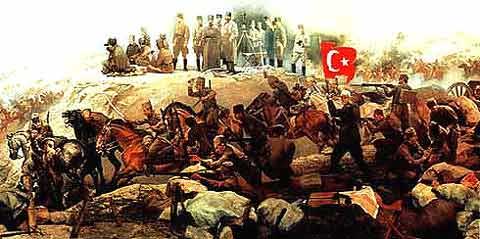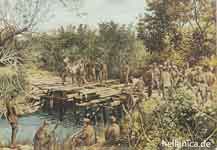.

Battle of the Sakarya, Painting from the Ataturk museum
| Battle of Sakarya | |||||||
|---|---|---|---|---|---|---|---|
| Part of The | |||||||
|
|||||||
| Combatants | |||||||
| Turkish Revolutionaries | Greece | ||||||
| Commanders | |||||||
| Mustafa Kemal Atatürk | Constantine I(nominal)
Gen.Papoulas(actual) |
||||||
| Strength | |||||||
| 95,000-105,000
(75,000 combatants) |
120,000
(77,000 combatants) |
||||||
| Casualties | |||||||
| 3,250 dead 13,800 wounded 5,070 missing number of prisoners unknown |
3,677 dead 18,869 wounded 354 missing number of prisoners unknown |
||||||
The Battle of the Sakarya or the Battle of the Sangarios in 1921 was an important engagement in the Greco-Turkish War (1919-1922), which is part of Turkish War of Independence . The battle was fought during August 23 - September 13, 1922, close to the banks of River Sakarya in the immediate vicinity of Polatlı, which is today a district of the Turkish capital Ankara
Active stage
In June 1921, the Greek army advanced to the River Sakarya, less than 100 km west of Ankara. On July 28, the decision to seek out and destroy the Turkish Army was taken. Papoulas planned convergent thrusts, Eastwards across the Sakarya and Northwards against the Turkish lines on the Ilica, a shallow tributaty of the Sakarya. On August 23, 1921, the Greeks attacked and broke through the Ilica line. Before them rose the Haymana plateau, 3000 feet high, dotted with higher hills, the chief of which were Mangal Dagi in the South and Chal Dagi in the centre. The Greeks took Mangal Dagi against weak Turkish opposition, much to Kemal's fury. In the face of Greek progress, Kemal ordered that no unit was to fall back even if neighbouring units did. Fevzi Pasha, the Turkish Chief General Staff, decided to hold on around Chal Dagi and brought in reinforcements. The shortening of the Turkish defensive line also helped.
The Greeks took Chal Dagi after fierce fighting on September 2, 1921. According to some sources Kemal fell into depression, but was prevented from issuing an order to retreat because of Fevzi; Kemal himself claimed he was unconcerned. Unknown to him, Papoulas was also considering retreat, disheartened by the heavy losses despite the important successes. He ordered retreat from September 4, after taking permission by the Greek government to act as he considered best. The Turks counter-attacked and took Chal Dagi on September 8, but were unable to pursue the enemy as their violent counter-attack was crushed by the Greek 7th division. The twenty-one day battle of attrition officially ended on September 13, 1921. The Greeks retreated in good order and still hoped to defend their base at Smyrna. They appealed to the Allies for help, but early in 1922, Britain, France and Italy decided that the Treaty of Sèvres could not be enforced and should be revised.

Results
In March 1922, the Allies proposed a ceasefire, but Kemal said there could be no settlement while the Greeks remained in Anatolia. In August, the Turks launched a new offensive, defeating the Greeks at the Battle of Dumlupinar near Afyon on August 30, 1922. Shortly after on September 9, 1922, the Turkish army liberated Smyrna. The "Great Fire of Smyrna" soon followed.
| Greco-Turkish War (1919-1922) |
|---|
| Ancient Greece
Science, Technology , Medicine , Warfare, , Biographies , Life , Cities/Places/Maps , Arts , Literature , Philosophy ,Olympics, Mythology , History , Images Medieval Greece / Byzantine Empire Science, Technology, Arts, , Warfare , Literature, Biographies, Icons, History Modern Greece Cities, Islands, Regions, Fauna/Flora ,Biographies , History , Warfare, Science/Technology, Literature, Music , Arts , Film/Actors , Sport , Fashion --- |
Retrieved from "http://en.wikipedia.org/"
All text is available under the terms of the GNU Free Documentation License

